Tip for some weekend reading: this great and funny conversation between writer Sherman Alexie and musician Neko Case:
Have a good one!
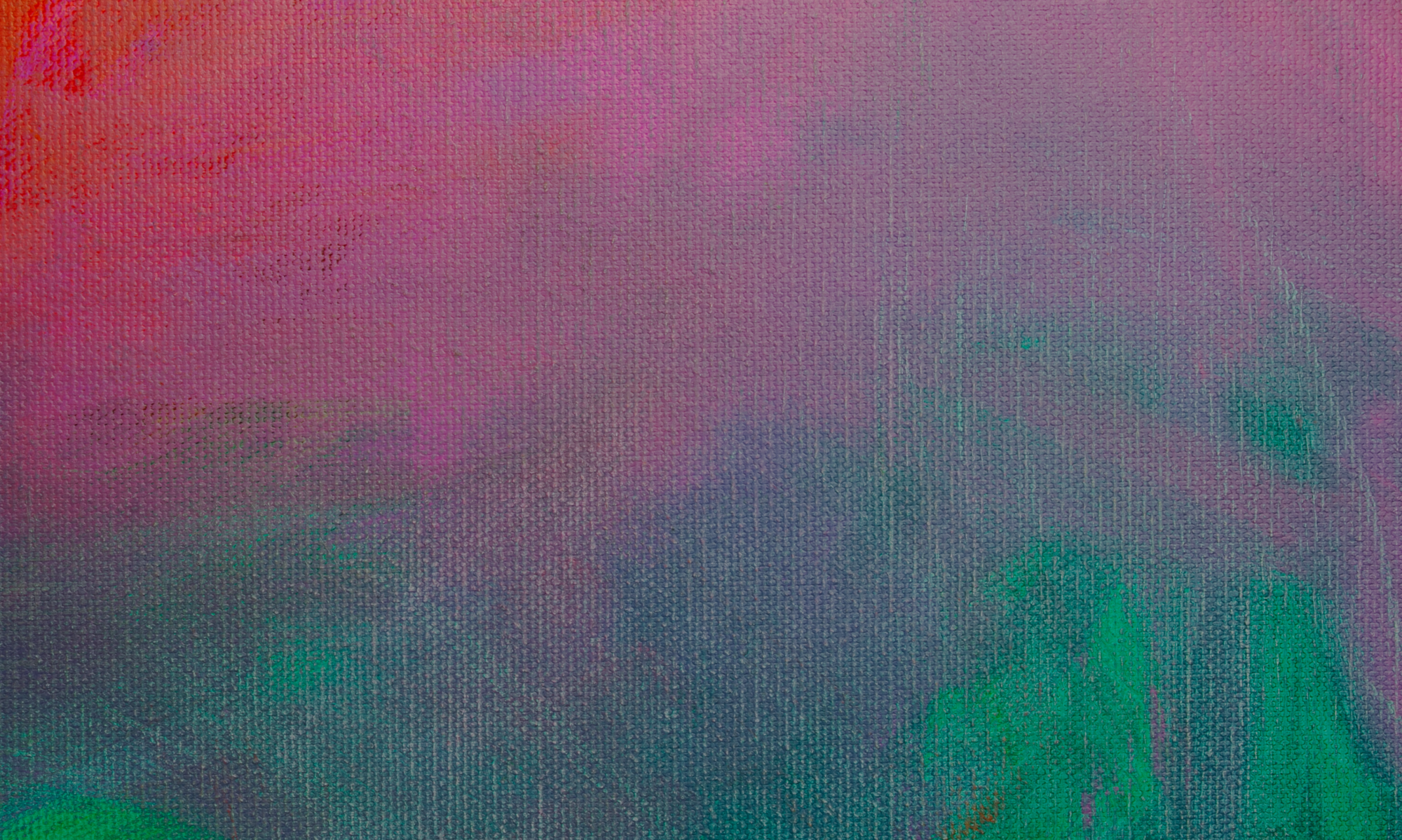
Gallery and Collection of Native American Art. Uppsala, Sweden.
Tip for some weekend reading: this great and funny conversation between writer Sherman Alexie and musician Neko Case:
Have a good one!
What is Kiva Gallery ?
Kiva Gallery specializes in art made by the Native people of North America and particularly the Southwest USA. This area is especially rich in cultural traditions, going back to the pottery and craftwork from the tribes of the middle ages, and continuing today with oil and acrylic paintings, sculptures, textile, as well as decidedly modern artistic expressions through graffiti and skateboarding, photography and graphic art.
Native culture today cannot be summed up with a few go-to terms and familiar motifs. Many contemporary artists are struggling with how to remain faithful to their cultural heritage while still updating its traditional idiom to modern times. 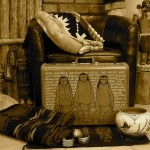
The mission of Kiva is to capture Native culture in a time of transition and translation. We choose to display artworks that will illuminate this process. Combining traditional arts and crafts – such as pottery and Kachina dolls; rugs and jewelry – with contemporary painting that relate to a broader art-historical, as well as pop-cultural, context, Kiva’s ambition is to demonstrate a culture of vibrancy, of energy and restlessness.
In the years that Kiva has been open, it has come to function as more that an art gallery. It has become an open forum of conversation and exchange about marginalized cultures. This is how we like it. Stop by for a coffee and a chat.
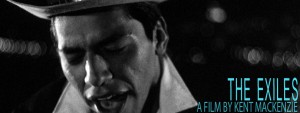 I’ve quickly realized that I want this blog to be not just a document of the Gallery’s activities, but somewhat of a posterboard for scattered thoughts on cultural artifacts related to Native culture and americana in general. Let me therefore draw some deserved attention to an unusually stark and uncompromising depiction of American Indians – Kent Mackenzie’s film ”The Exiles”. Like the fate of many Native Americans themselves, the film has suffered from cultural invisibility for many years. I first came across clips of it in Thom Andersen’s essay film ”Los Angeles Plays Itself” and was struck by the rawness of the images. As was many others. The film has since been restored and released on DVD.
I’ve quickly realized that I want this blog to be not just a document of the Gallery’s activities, but somewhat of a posterboard for scattered thoughts on cultural artifacts related to Native culture and americana in general. Let me therefore draw some deserved attention to an unusually stark and uncompromising depiction of American Indians – Kent Mackenzie’s film ”The Exiles”. Like the fate of many Native Americans themselves, the film has suffered from cultural invisibility for many years. I first came across clips of it in Thom Andersen’s essay film ”Los Angeles Plays Itself” and was struck by the rawness of the images. As was many others. The film has since been restored and released on DVD.
”The Exiles” begins with a sequence of Edward Curtis’s photographs of traditional Indians set to tribal drumming and chanting. But this is no return to times past. We are soon landed in 1960s Los Angeles among a group of Native Americans who have exiled from the reservation only to find themselves in an urban limbo of sorts, passing their unemployed time by drinking, fighting, flirting, and gambling. The film follows the group throughout twelve hours of their lives, beginning at nightfall and ending as a new dawn rises. It will be a night of thunderbird-guzzling, drunken joy, drunken resignation, romantic missteps, drunk driving, air-piano playing, bar-brawling, but also of retying old collective bonds as the night is ended on the hilltops above Los Angeles where Natives young and old come together to sing traditional Indian songs.
Not a documentary in the strictest sense of the term, the individuals of the film nevertheless more or less play themselves. The visual footage is complemented by a voice-over consisting of authentic interviews of the ”actors” voicing their real-life attitudes and concerns. This device supplies the apparently carefree antics with an undertow of complexity. The effect of the voice-over is particularly striking when coupled to Yvonne’s beautifully stoic face.
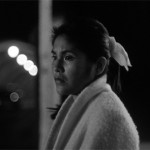 Yvonne is the most judicious of the bunch. Being pregnant, she goes to the movies while the others go out drinking, dreaming of a brighter future where husband Homer will change his reckless ways and become a responsible father for his child. If not, she’s sure she’ll manage on her own. Somehow.
Yvonne is the most judicious of the bunch. Being pregnant, she goes to the movies while the others go out drinking, dreaming of a brighter future where husband Homer will change his reckless ways and become a responsible father for his child. If not, she’s sure she’ll manage on her own. Somehow.
In ”Los Angeles Plays Itself”, ”The Exiles” was celebrated for its respectful treatment of the city of Los Angeles. Indeed, the attention to detail makes the city come alive, taking in ambient sounds and the rundown charm and maze-like layout of the now vanished neighborhood Bunker Hill, which has been the setting for many a Film Noir. Historically, Bunker Hill was for long disconnected from the rest of Los Angeles due to its elevated placement. Later, the two areas were connected by a long tunnel through the hill. This historic background provides some opportune fodder for symbolism. The tunnel figures prominently in the film. It thereby underscores the transitional in-betweenness suggested by Homer, of being transplanted from one culturally segregated, but cohesive, community into an urban diaspora.
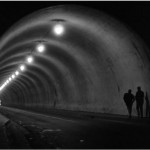 For some, the film is problematic for seemingly contributing to the stereotype of the drunken Indian. I think this is to miss the point. ”The Exiles” is primarily a poem of the night – of its lures and pitfalls, sure, but also of it as medium for a class of people without means to exercise a bit of freedom, however destructive this freedom may be. The darkness of night belongs to them because they are invisible even during the day. As such, ”The Exiles” stands next to Bruce Springsteen’s ”Night” as a melancholy paean to the liberations of night.
For some, the film is problematic for seemingly contributing to the stereotype of the drunken Indian. I think this is to miss the point. ”The Exiles” is primarily a poem of the night – of its lures and pitfalls, sure, but also of it as medium for a class of people without means to exercise a bit of freedom, however destructive this freedom may be. The darkness of night belongs to them because they are invisible even during the day. As such, ”The Exiles” stands next to Bruce Springsteen’s ”Night” as a melancholy paean to the liberations of night.
As the sun rises and the twelve hours draw to a close, the group of friends – exhausted – stagger home. The last words before the film fades is ”tonight we’ll do it all again.” Springsteen sang: ”you run sad and free until all you can see is the night.”
Another Kiva Gallery favorite is Ryan Singer. Some aspects of his art lend themselves to the classification of ”lowbrow”. Indeed, in some instances the influence of the aesthetics of the lower strata of culture is obvious. One often recognizes elements from comic book art and poster design – those of Frank Kozik in particular – in Singer’s art.
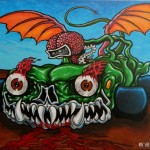
While on the one hand a pop cultural muncher of americana, other work by Singer offers more astute social commentary.The darker aspects of american culture are present too – all too present. Some of his recent paintings capture the pervading sense of alienation and disconnect from Edward Hopper’s paintings, but supplements it with a more precise cause – alcohol. Excessive drinking has of course been the source of demise of many a Native American. Singer, however, seems to shun personal blame in order to cast light on the extent to which it has been used as a political weapon.

Amidst the arrows, guns and dead bodies in ”Flying Engine”, bottles lie strewn throughout the battlefield as if to suggest that alcohol was a dominant weapon in the white man’s conquer of the land.
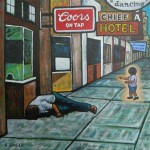
In ”Returning to Childhood” the ever present gates to alcoholic oblivion remains a force of oppression and control.
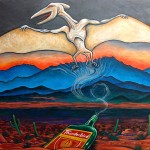
…Personally, Singer’s drinking preferences lean toward the more modest stimulant of coffee.
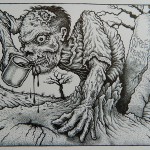
I’m soon off to the deserts and the Indian markets of southwest USA again, and one stop on the way will definitely be LACMA in Los Angeles which is hosting a large retrospective exhibition on the work of Stanley Kubrick. One film that I’m particularly interested in is ”The Shining”. Far from being a gore-hound, however, it is not the excessive bloodshed that draws me. Instead I will view it as an important reminder of the tragic past of the American Native People and the silence that still surrounds the historical atrocities. This is perhaps not the most obvious way to approach the film but I have journalist Bill Blakemore to thank for it.
In an influential article from 1987, Blakemore suggested that the genocide of the Native American is in fact the central, albeit hidden, theme of ”The Shining”. Indeed, Indian motifs and references abound in ”The Shining”. The Overlook Hotel, where the bloody action takes place, is itself said to be built on an Indian burial ground. Inside the hotel, the Colorado lounge, where Jack is writing his ”epic”, is adorned with a traditional Navajo textile. In the freezer, the shelves are stocked with cans of Calumet (a word for peace pipe) baking powder which are decorated by the cliché image of an Indian chief.
As Blakemore has it, all these references add up to ”The Shining” ”really” being about America’s preference to overlook the genocide by means of which its civilization is established.
Blakemore concludes on these dismal yet noteworthy words: ”Kubrick is examining in this movie not only the duplicity of individuals, but of whole societies that manage to commit atrocities and then carry on as though nothing were wrong. That’s why there have been so many murders over the years at the Overlook; man keeps killing his family and forgetting about it, and then doing it again… Though [Kubrick] has made here a movie about the arrival of Old World evils in America, he is exploring most specifically an old question: Why do humans constantly perpetuate such ”inhumanity” against humans? That family is the family of man.”

Kubrick was of course notoriously tight-lipped as to the ”true” meaning of his films. Consequently, they have spawned wildly different interpretations. Blakemore’s perspective is, however, one that I find not only plausible but also most politically urgent. It allows one to inject with moral outrage the bloodbaths that gushes forth on screen as well as those that have soiled the ground of the American nation.